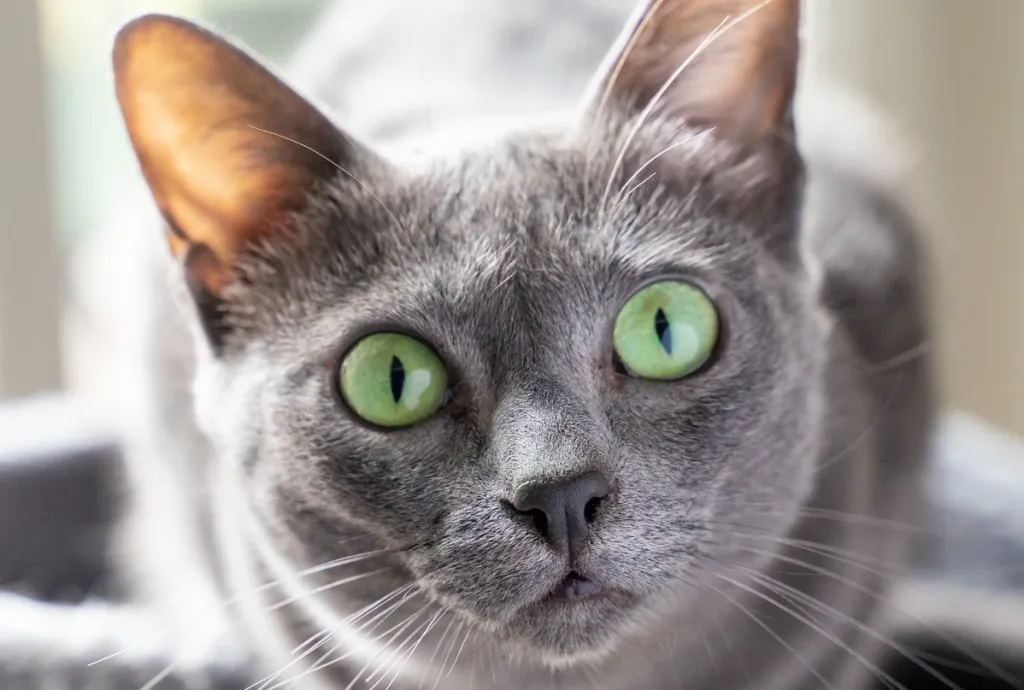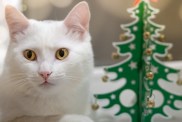The Korat cat, with its striking silver-blue coat and captivating green eyes, is a cat breed that exudes elegance and charm. Originating from Thailand, the Korat is revered not only for its physical beauty but also for its rich cultural significance. The Korat cat is called the “good luck cat” in its native land, and is steeped in ancient folklore and believed to bring prosperity and happiness to its owners.
Beyond its appearance, the Korat is beloved for its gentle and affectionate nature. These cats form strong bonds with their human companions and are known to be devoted and loyal. They thrive on human interaction and enjoy being part of family activities. Despite their affectionate nature, Korats can also be independent and may appreciate some alone time, making them adaptable to various living situations.
When considering a Korat, it’s advisable to prioritize adopting from rescue organizations or shelters to provide a loving home to a cat in need. However, if you decide to purchase a Korat kitten, it’s crucial to choose a reputable breeder. Conduct thorough research to ensure that the breeder follows ethical practices and prioritizes the well-being of their cats. Reputable Korat breeders prioritize the health and temperament of their cats, conduct necessary health screenings, and provide a nurturing environment for the kitties. This active approach ensures that you bring home a healthy and happy kitty while discouraging unethical breeding practices.
Quick Facts
- Origin: Thailand
- Size: Medium
- Breed Group: Shorthair
- Lifespan: 12-15 years
- Coat: Short, dense, and silky, with a distinctive blue or silver-tipped coat
- Temperament: Intelligent, playful, and affectionate
- Exercise Needs: Moderate
- Training: Easy to train
- Grooming: Weekly brushing
- Health: Generally healthy, but can be prone to certain genetic health conditions, such as progressive retinal atrophy (PRA) and feline hypertrophic cardiomyopathy (HCM)
- Gifting Korat cats, not selling them, was the norm until recently. They were often wedding gifts.
- The earliest believed mention of the Korat cat is in 1350 in “Tamra Maew.” However, it is not definitively a Korat cat because of the lack of details.
- Korats are always fully blue, but they are related to Thai Lilac and Thai Blue point cats.
Korat Pictures
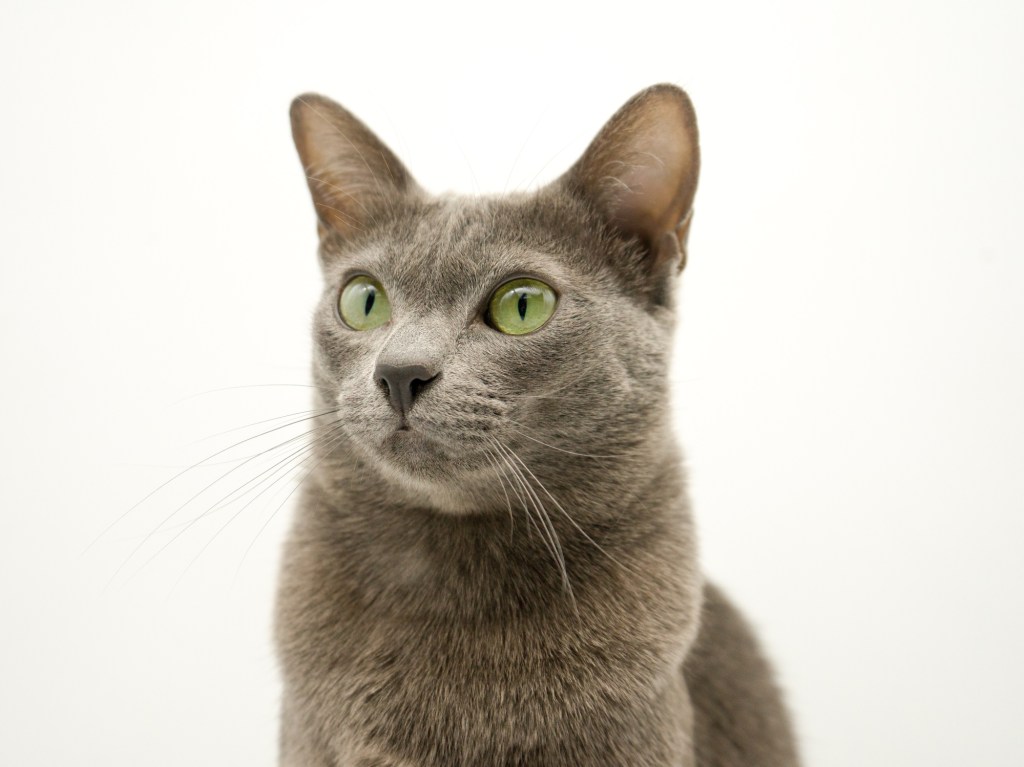
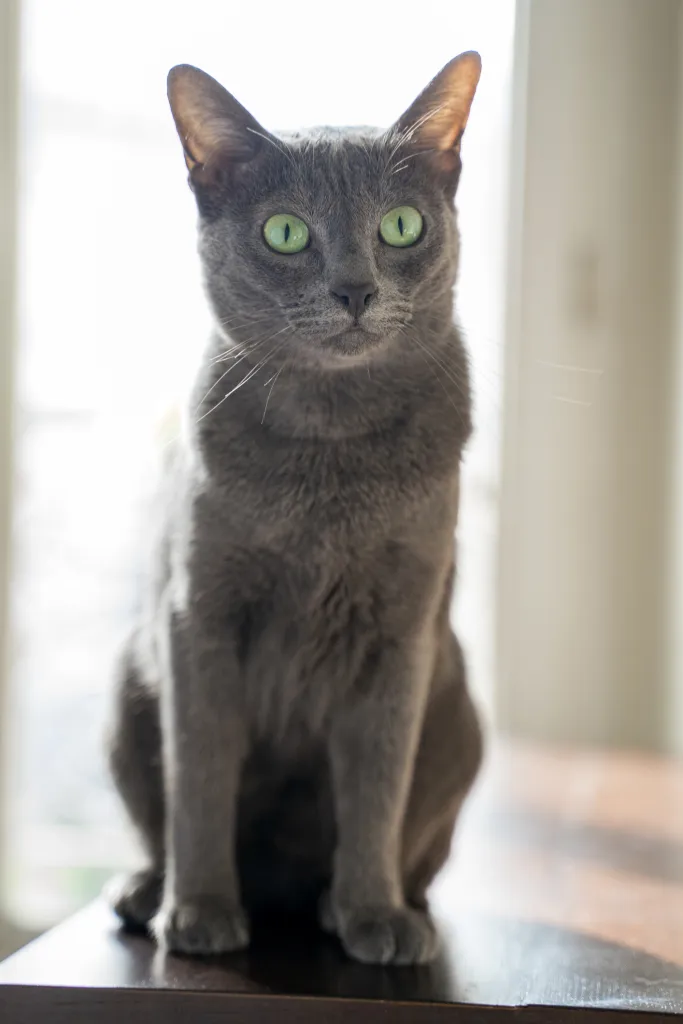

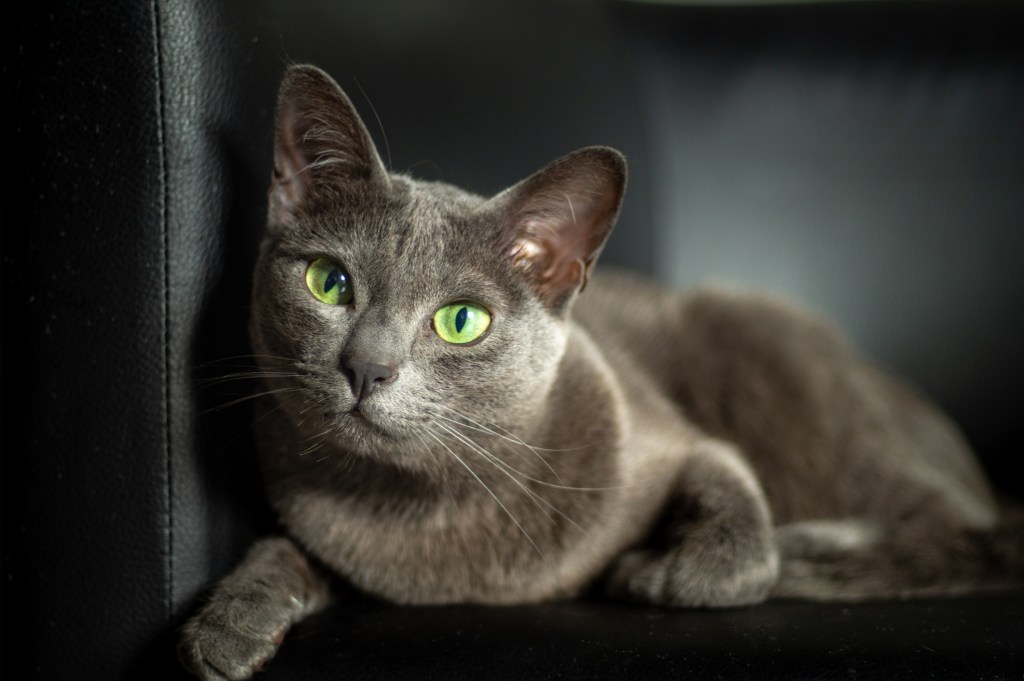
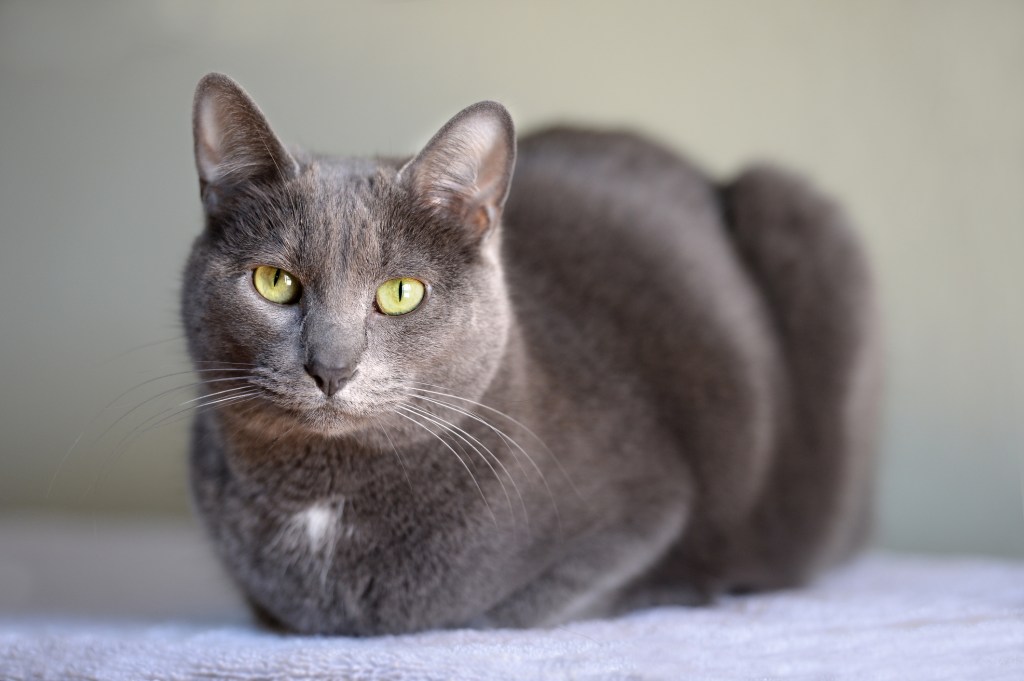

-
Affectionate with Family
Some cat breeds are typically independent and aloof, even if they’ve been raised by the same person since kittenhood; others bond closely to one person and are indifferent to everyone else; and some shower the whole family with affection. Breed isn’t the only factor that goes into affection levels; cats who were raised inside a home with people around feel more comfortable with humans and bond more easily.

See Cats Less Affectionate with Family -
Amount of Shedding
If you’re going to share your home with a cat, you’ll need to deal with some level of cat hair on your clothes and in your house. However, shedding does vary among the breeds. If you’re a neatnik, you’ll need to either pick a low-shedding breed or relax your standards. This furniture cover can make it easier to clean up cat hair and keep it off your sofa!
-
General Health
Due to poor breeding practices, some breeds are prone to certain genetic health problems. This doesn’t mean that every cat of that breed will develop those diseases; it just means that they’re at an increased risk. If you’re looking only for purebred cats or kittens, it’s a good idea to find out which genetic illnesses are common to the breed you’re interested in.
-
Potential for Playfulness
Some cats are perpetual kittens—full of energy and mischief—while others are more serious and sedate. Although a playful kitten sounds endearing, consider how many games of chase the mouse-toy you want to play each day, and whether you have kids or other animals who can stand in as playmates. A classic wand cat toy like this one is perfect for playful felines!
-
Tendency to Vocalize
Some breeds sound off more often than others with meows, yowls, and chattering. When choosing a breed, think about how the cat vocalizes and how often. If constant “conversation” drives you crazy, consider a kitty less likely to chat.
-
Kid-Friendly
Being tolerant of children, sturdy enough to handle the heavy-handed pets and hugs they can dish out, and having a nonchalant attitude toward running, screaming youngsters are all traits that make a kid-friendly cat. Our ratings are generalizations, and they’re not a guarantee of how any breed or individual cat will behave; cats from any breed can be good with children based on their past experiences and personality.
-
Friendly Toward Strangers
Stranger-friendly cats will greet guests with a curious glance or a playful approach; others are shy or indifferent, perhaps even hiding under furniture or skedaddling to another room. However, no matter what the breed, a cat who was exposed to lots of different types, ages, sizes, and shapes of people as a kitten will respond better to strangers as an adult.
-
Easy to Groom
Some breeds require very little in the way of grooming; others require regular brushing to stay clean and healthy. Consider whether you have the time and patience for a cat who needs daily brushing. You should definitely pick up this awesome de-shedding tool for cats of any hair length!
-
Intelligence
Some cat breeds are reputed to be smarter than others. But all cats, if deprived the mental stimulation they need, will make their own busy work. Interactive cat toys are a good way to give a cat a brain workout and keep them out of mischief. This scratcher cat toy can keep your smart kitty busy even when you’re not home!
-
Pet Friendly
Friendliness toward other household animals and friendliness toward humans are two completely different things. Some cats are more likely than others to be accepting of other pets in the home.
Korat History
Move over, rabbit’s foot. The Korat is a living good-luck charm in his home country of Thailand, where he is also known as the Si-Sawat cat. The silver-blue cats with the emerald-green eyes are said to date to the 14th century based on their depiction in ancient literature. They were popular gifts, always presented in pairs, and had special meaning when given to brides because of their association with prosperity and fertility.
The name Korat comes from the region in northeast Thailand where the cats are thought to have originated. It’s unclear when Korats first came to the West. A cat that resembled a Korat was exhibited at a show in England in 1896, but whether it was truly a Korat (pronounced ko-raht) or simply a self-blue Siamese—meaning solid-colored—is not known.
The first known Korats imported into the United States arrived in 1959. Appropriately, they had been given as gifts to an American couple who were returning to the U.S. after the husband had retired from the Foreign Service. The Cat Fanciers Association recognized the breed in 1967, two years after Korat breeders founded the Korat Cat Fanciers Association to promote the breed.
Wherever they are found, all Korats can climb their family tree all the way back to Thailand. They are a natural breed and have never been outcrossed to any other breed as part of their development or to create another breed. They are recognized by all the major cat associations.
Korat Size
This is a medium-size cat, weighing from 6 to 10 pounds.
Korat Personality
The smart and opinionated Korat is possessive of his people. He likes to stay close by and won’t desert them for visitors. He gives his heart to one or two people whose company he prefers, or with whom he spends the most time, but he’s certainly willing to accept affection from others as well. Be aware of this propensity before you get a Korat, just in case having a cat follow you around all the time would drive you crazy.
A Korat is not a loner. He does best with companionship, whether that is someone who works at home or another animal. There’s a reason, it seems, that traditionally they were always given in pairs. A Korat who is frequently left alone or ignored may develop behavior problems such as aggression or separation anxiety. That’s not to say that adult Korats can’t switch their affections. Cats placed in new homes quickly adapt and bond closely with their new family.
This is an energetic cat who enjoys learning tricks, playing fetch and even walking on leash. It’s easy to teach household rules to the Korat if you reward him with petting, a happy “Good cat” or a treat. Limit corrections to a loud “No!” or hand clap. If you have multiple cats, be sure you have plenty of toys to go around. The Korat did not learn to share in kittygarten, and he can be stubborn about giving up toys or other objects that he views as his.
Although he can be bold with definite likes and dislikes, the Korat is generally a quiet cat who likes a quiet environment. Although he’s not known for being talkative, he is capable of making many different sounds, from a chirp to a scream, when he wants to get his point across. Choose the Korat if you enjoy having a lap cat. He will be pleased to fulfill this desire any time you like.
Korat Health
Both pedigreed cats and mixed-breed cats have varying incidences of health problems that may be genetic in nature. Korats are generally healthy, but they have a couple of issues buyers should be aware of:
Anesthesia Sensitivity: A genetic neuromuscular degenerative disease as well as low body fat, which can make them sensitive to anesthesia, GM1 and GM2 gangliosidosis occur when cats lack particular enzymes that are necessary for proper functioning of the nervous system. Fortunately, tests are available to identify cats that carry the diseases, so the condition is uncommon. Korats typically have a low percentage of body fat, so veterinarians should take this into account when determining how much and what type of anesthesia to given when a Korat is undergoing any type of surgery.
Be sure to ask a breeder about the incidence of health problems in her lines and what testing has been done for any that are genetic in nature. In the case of GM1 or GM2, both parents should have been tested, and if one is positive or a carrier, the kittens should be tested as well.
Korat Care
The Korat’s short single coat requires little grooming. Comb it weekly to remove any dead hairs. A bath is rarely necessary. Brush the teeth to prevent periodontal disease. Daily dental hygiene is best, but weekly brushing is better than nothing. Trim the nails every couple of weeks. Wipe the corners of the eyes with a soft, damp cloth to remove any discharge. Use a separate area of the cloth for each eye so you don’t run the risk of spreading any infection.
Check the ears weekly. If they look dirty, wipe them out with a cotton ball or soft damp cloth moistened with a 50-50 mixture of cider vinegar and warm water. Avoid using cotton swabs, which can damage the interior of the ear.
Keep the litter box spotlessly clean. Cats are very particular about bathroom hygiene. It’s a good idea to keep a Korat as an indoor-only cat to protect him from diseases spread by other cats, attacks by dogs or coyotes, and the other dangers that face cats who go outdoors, such as being hit by a car. Korats who go outdoors also run the risk of being stolen by someone who would like to have such a beautiful cat without paying for it.
Korat Coat Color And Grooming
With his silver-tipped blue coat and huge green eyes—“as sparkling as the dewdrops on a lotus leaf”—the Korat is one of Thailand’s most beautiful exports. He is noted as well for his heart-shaped head, large ears and alert expression. A Korat’s eyes are blue at birth. As he matures, the eyes turn to amber, the pupil surrounded by a fringe of green. By the time the cat is two to four years old, the eyes have become the brilliant green for which the breed is known.
The short single coat has hairs that are a light blue at the roots, then deepen, ending in a silver tip, producing a halo effect. Unlike some breeds, the coat has its silver-blue color from the time kittens are born, although kittens may have what are known as “ghost tabby” markings. These should disappear with maturity. The Korat’s nose leather, lips and paw pads range from dark blue to lavender.
Children And Other Pets
Korats will appreciate the attentions of a child who treats them respectfully, and they enjoy playing and learning tricks. With proper supervision, they can be a good companion for children.
Like many cats that originated in Southeast Asia, Korats tend to prefer other Korats. They can get along with other cats, and with dogs, but they expect to have pride of place. This may or may not go over well with other animals. The Korat likes to have company, however, and if he spends a lot of time with another cat or dog, they will likely become close friends.
Korat Rescue Groups
More Info For You
If you’re also looking for a dog, check out DogTime’s dog breed page!
